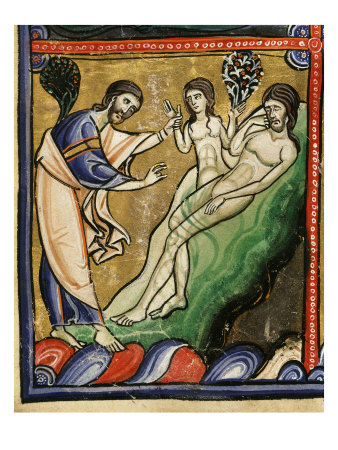 In 2001, Ziony Zevit (a biblical scholar) published, along with Scott F. Gilbert (a biology professor), a letter in the American Journal of Medical Genetics (101:284-5), entitled Congenital Human Baculum Deficiency: The Generative Bone of Genesis 2:21-23.
In 2001, Ziony Zevit (a biblical scholar) published, along with Scott F. Gilbert (a biology professor), a letter in the American Journal of Medical Genetics (101:284-5), entitled Congenital Human Baculum Deficiency: The Generative Bone of Genesis 2:21-23.
In the letter, the authors essentially suggest that the bone which was taken by Yahweh to form the woman was Adam’s penis bone, his baculum. They write, “Whereas most mammals […] and most primates […] have a penile bone, human males lack this bone and must rely on fluid hydraulics to maintain erections.” If we assume “it was Adam’s baculum that was removed in order to make Eve,” the authors write, then the story in Genesis 2 which has Yahweh apparently create woman using a rib (Hebrew, tsela), which lacks “any intrinsic generative capacity,” makes much more sense. Not only would the “rib” then be associated with generation and procreation, but it also explains, for the ancient Israelites, why the human male did not have a penis bone.
There are a few problems with this theory, and personally I don’t think it holds much water. Firstly, the Hebrew text of Genesis 2:21 does not support the authors’ thesis. It reads, “Then Yahweh of the gods caused a trance to fall upon the man (Adam), and while he slept, he took ahat missalotayv…” The phrase ahat (lit. “one of”) missalotayv (“from his tselas”) implies that whatever Yahweh took from man, there was more than one of them to begin with. The construct form of ahad (one) coupled with the plural of tsela lends more weight to the traditional idea that this is a rib bone, and not the baculum.
Secondly, I believe the authors are mistaken when they claim the rib lacks “any intrinsic generative capacity” and “[a] rib has no particular potency nor is it associated mythologically or symbolically with any human generative act.” The major problem here is they are discounting Genesis 2 as possibly the first instance of this, but thankfully we do have evidence from Sumerian culture which links the rib with generation. In Enki and Ninhursag (a Sumerian text which I’m working with at the moment), the god Enki becomes ill, and the mother goddess Ninhursag cures parts of his body by giving birth to gods who can help his ailments. One of these is Ninti,
[Ninhursag said]: “My brother, which part of you hurts?”
“My rib hurts me.”
She [Ninhursag] gave birth to Ninti out of it (lines 268-69).
This text works based on the pun between the goddess Ninti and the rib (in Sumerian, ti). The goddess’ name literally means “Lady of the Rib,” and through her Enki’s rib pain, presumably, departs. Interestingly, the Sumerian word for “to make live” is also ti, and so Ninti may also mean “The Lady who makes live.” The pun between life and ribs is thus preserved in Sumerian mythology. In Genesis 2, Eve is both made from a rib and called the “mother of all living” (Gen. 3:20), and this account is likely a preservation of this mythic association.
My last criticism of the theory is its reliance on a medical and demythologising paradigm not operational when the biblical authors wrote their texts. It’s in a similar vein to those who would explain the Levitical prohibition on pork by recourse to the idea that its purpose was to stop disease spreading in an arid Israelite climate. Such approaches ignore larger mythic tropes at the time these texts were written, or at least orally transmitted. Just as you can’t use Genesis 1 to explain astrophysics, it would be inappropriate to use a 21st century biological framework to categorically explain parts of quite complex mythologies.
—
See further, http://blogs.ucl.ac.uk/researchers-in-museums/2012/11/26/how-did-man-lose-his-penis-bone/
Hi, bowing to your evident scholarship and excellent reasoning, here’s a couple of thoughts:
You say that the baculum could only be referred to in the singular and that the term ‘one of’ implies that it can only be applied to something of which there is more than one, so couldn’t the text have meant ‘one of his bones’? I know that’s just my own uninformed guess at how the Hebrew language works, but I wonder if you might have overlooked that possibility.
Secondly, ancient people may not have the wealth of biological knowledge we have today, but just about every mammal has been killed, cut up, eaten and otherwise used as clothing, decoration, tools and ritual objects in the past, and by people much more commonly aware of the anatomical detail of their food than we are today with our sealed packets of prepared meat. In ancient cultures, the sexual organs of creatures have had ritual significance, as walrus bacula have done among Arctic peoples until quite recent times. Wouldn’t it be fair to think that ancient people may have noticed that virtually every other male mammal had a bone in his penis except us and devised a Just So story as an explanation for it?
Please don’t think I’m one of those nutjobs out for a religious fight, I’m just curious.
Oh dear, I’ve just done a bit of Googling and realise what a raging debate this all is, about the meaning of the word ‘tsela’ etc. It seems that it has never meant ‘bone’, but could have meant anything from a lean-to extension on a building to an appendage. I might get my coat and leave this room now…